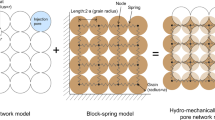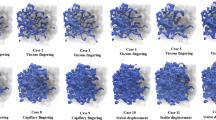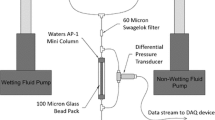Abstract
A basic re-examination of the traditional dimensional analysis of microscopic and macroscopic multiphase flow equations in porous media is presented. We introduce a ‘macroscopic capillary number’\(\overline {Ca}\) which differs from the usual microscopic capillary number Ca in that it depends on length scale, type of porous medium and saturation history. The macroscopic capillary number\(\overline {Ca}\) is defined as the ratio between the macroscopic viscous pressure drop and the macroscopic capillary pressure.\(\overline {Ca}\) can be related to the microscopic capillary number Ca and the LeverettJ-function. Previous dimensional analyses contain a tacit assumption which amounts to setting\(\overline {Ca}\) = 1. This fact has impeded quantitative upscaling in the past. Our definition for\(\overline {Ca}\), however, allows for the first time a consistent comparison between macroscopic flow experiments on different length scales. Illustrative sample calculations are presented which show that the breakpoint in capillary desaturation curves for different porous media appears to occur at\(\overline {Ca}\) ≈ 1. The length scale related difference between the macroscopic capillary number\(\overline {Ca}\) for core floods and reservoir floods provides a possible explanation for the systematic difference between residual oil saturations measured in field floods as compared to laboratory experiment.
Similar content being viewed by others
References
Dullien, F.:Porous Media—Fluid Transport and Pore Structure, Academic Press, San Diego, 1992.
Bear, J. and Bachmat, Y.:Introduction to Modeling of Transport Phenomena in Porous Media, Kluwer Acad. Publ., Dordrecht, 1990.
Lake, L.:Enhanced Oil Recovery, Prentice-Hall, Englewood Cliffs, 1989.
Willhite, G.:Waterflooding, SPE Textbook Series 3, Society of Petroleum Engineers, 1986.
Bear, J.:Dynamics of Fluids in Porous Media, Elsevier, New York, 1972.
Larson, R., Davis, H. and Scriven, L.: Displacement of residual nonwetting fluid from porous media,Chem. Eng. Sci. 36 (1981), 75.
Lenormand, R. and Zarcone, C.: Physics of blob displacement in a two-dimensional porous medium,SPE Proc., SPE Conference, Tulsa, 1986, p. 23.
Wardlaw, N. and McKellar, M.: Oil blob populations and mobilization of trapped oil in unconsolidated packs,Canad. J. Chem. Eng. 63 (1985).
Morrow, N., Chatzis, I. and Taber, J.: Entrapment and mobilization of residual oil in bead packs,SPE Proc. 60th SPE Conference, Las Vegas, 1985.
Leverett, M., Lewis, W. and True, M.: Dimensional-model studies of oilfield behavior,Trans. AIME 146 (1942), 175.
Rapaport, L.: Scaling laws for use in design and operation of water-oil flow models,Trans. AIME 204 (1955), 143.
Geertsma, J., Croes, G. and Schwarz, N.: Theory of dimensionally scaled models of petroleum reservoirs,Trans AIME 207 (1956), 118.
Perkins, F. and Collins, R.: Scaling laws for laboratory flow models of oil reservoirs,Trans. AIME (1960), 69.
De Gennes, P.: Wetting: Statics and dynamics,Rev. Mod. Phys. 57 (1985), 827.
Burridge, R. and Keller, J.: Poroelasticity equations derived from microstructure,J. Acoust. Soc. Am. 70 (1981), 1140.
Hilfer, R.: Geometric and dielectric characterization of porous media,Phys. Rev. B 44 (1991), 60.
Hilfer, R.: Local porosity theory for flow in porous media,Phys. Rev. B 45 (1992), 7115.
Hilfer, R.: Transport and relaxation phenomena in porous media, to appear inAdv. in Chem. Phys.
Whitaker, S.: Flow in porous media II: The governing equations for immiscible two-phase flow,Transport in Porous Media 1 (1986), 105.
Ariault, J.: Nonsaturated deformable porous media,Transport in Porous Media 2 (1987), 45.
Kalaydijan, F.: A macroscopic description of multiphase flow in porous media involving spacetime evolution of fluid/fluid interface,Transport in Porous Media 2 (1987), 587.
Kalaydijan, F.: Origin and quantification of coupling between relative permeabilities for two-phase flow in porous media,Transport in Porous Media 5 (1990), 215.
Heaviside, J.: Measurement of relative permeability, in N. Morrow (ed.),Interfacial Phenomena in Petroleum Recovery, Surfactant Science Series 36, Marcel Dekker, New York, 1991, p. 377.
Morrow, N.: Introduction to interfacial phenomena in oil recovery, in N., Morrow (ed.)Interfacial Phenomena in Petroleum Recovery, Surfactant Science Series 36, Marcel Dekker, New York, 1991, p. 1.
Author information
Authors and Affiliations
Rights and permissions
About this article
Cite this article
Hilfer, R., Øren, P.E. Dimensional analysis of pore scale and field scale immiscible displacement. Transp Porous Med 22, 53–72 (1996). https://doi.org/10.1007/BF00974311
Received:
Issue Date:
DOI: https://doi.org/10.1007/BF00974311




